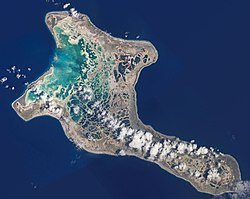Kiritimati
| Kiritimati (Christmas Island) | |
|---|---|
| Atoll | |
 Photograph from the International Space Station |
|
| Location in Kiribati | |
| Coordinates: 01°52′N 157°24′W / 1.867°N 157.400°WCoordinates: 01°52′N 157°24′W / 1.867°N 157.400°W | |
| Country | Kiribati |
| Island group | Line Islands |
| Area | |
| • Total | 388.39 km2 (149.96 sq mi) |
| Population (2015 Census) | |
| • Total | 6,447 |
| • Density | 17/km2 (43/sq mi) |
Kiritimati, or Christmas Island, is a Pacific Ocean raised coral atoll in the northern Line Islands. It is part of the Republic of Kiribati.
The name "Kiritimati" is a rather straightforward respelling of the English word "Christmas" in the Kiribati language, in which the combination ti is pronounced s, and the name is thus pronounced /kəˈrɪsməs/. Although most non-Kiribati people still correctly say the island's name as Christmas or Christmas Island, the change in spelling sometimes results in those not "in the know" to mispronounce it as the letter combination "Kiritimati" would be pronounced in English.
The island has the greatest land area of any coral atoll in the world, about 388 square kilometres (150 square miles); its lagoon is roughly the same size. The atoll is about 150 km (93 mi) in perimeter, while the lagoon shoreline extends for over 48 km (30 mi). Kiritimati comprises over 70% of the total land area of Kiribati, a country encompassing 33 Pacific atolls and islands.
It lies 232 km (144 mi) north of the Equator, 2,160 km (1,340 mi) south of Honolulu, and 5,360 km (3,330 mi) from San Francisco. Kiritimati Island is in the world's farthest forward time zone, UTC+14, and is one of the first inhabited places on Earth to experience the New Year (see also Caroline Atoll, Kiribati). Despite being 2,460 km (1,530 mi) east of the 180 meridian, a 1995 realignment of the International Date Line by the Republic of Kiribati moved Kiritimati to west of the dateline.
Nuclear tests were conducted on and around Kiribati by the United Kingdom in the late 1950s, and by the United States in 1962. During these tests islanders were not evacuated. Subsequently, British, New Zealand, and Fijian servicemen as well as local islanders have claimed to have suffered from exposure to the radiation from these blasts.
...
Wikipedia

